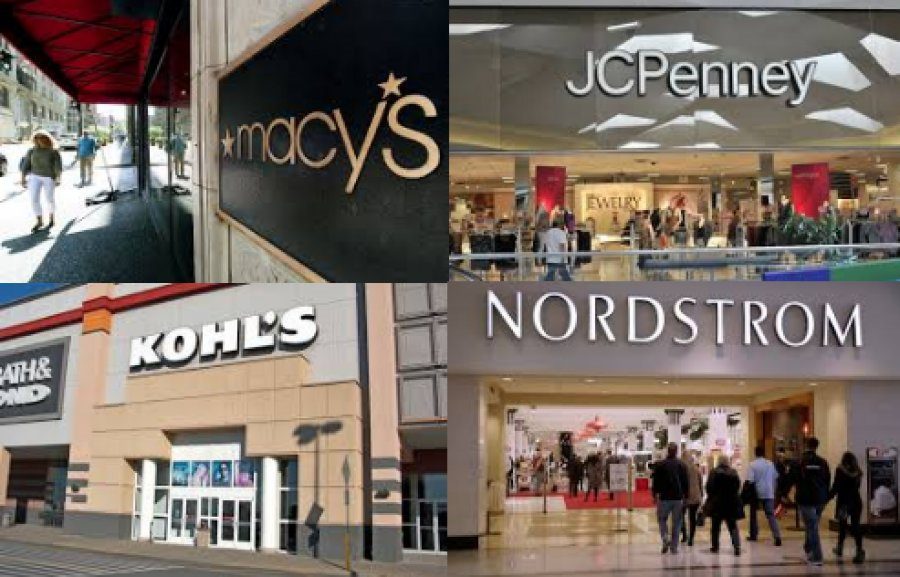Although the NRF reported that overall holiday retail sales increased 4% in 2016, traditional retailers, predictably, did not share equally in the bounty. While Amazon posted a 55% profit increase earlier this month, department stores such as Macy’s, Kohl’s, Nordstrom and JCPenney are still struggling to boost quarterly results. In Q4:
-
Macy’s posted its eighth straight quarterly comparable sales drop at 2.1%, with total net sales slipping 4% to $8.5 billion. Additionally, the brand saw year-over-year income decrease from $544 million to $475 million;
-
Kohl’s saw comparable sales dip 2.2%, along with a sales decline of 3% to $6.2 billion. Net income slid 15%, to $252 million;
-
Nordstrom had a better half than Macy’s and Kohl’s, increasing net sales 2.4% to $4.2 billion and showing a less impactful comparable sales dip at 0.9%.Net income for the quarter came in at $201 million, up 11.7% year-over-year; and
-
JCPenney saw 0.7% decline in comparable stores and a 0.9% decrease in net sales to $3.96 billion, but generated a $192 million profit, its first since 2010. The retailer also is closing up to 140 stores in the next few months.
All four of these brands, as well as other traditional brands such as Sears and Dillard’s are undertaking mass store closures in 2017. The reasons are familiar: the continued decline of foot traffic and increased competition from off-price retailers and smaller, nimbler brands. Traditional retailers now have to take tighter control of inventory to prevent drastic declines in margins, but the result is often short-term losses. Additionally, these brands all face a constant battle against one of today’s retail superpowers: Amazon.
Fight With Amazon Drains Retailers’ Wallets
Playing catch-up with Amazon isn’t working for most of the big brands — or brands in general for that matter — due to the rising cost of giving consumers what they want.
In fact, only 10% of CEOs say they have refined their offerings and are now able to make a profit while still fulfilling omnichannel demands, according to a survey from JDA and PwC. The same survey showed that just 12% of CEOs say their companies provide a seamless shopping experience across channels, down from 19% in 2014. As the cost of providing an omnichannel experience continues to rise while profit margins shrink, many brands are scaling back on omnichannel commitments.
With 74% of retailers saying the cost of customer returns is eroding profit to at least some extent, it’s clear that brands have taken a financial hit by going the extra mile. Consumers now demand options such as buy online/pickup in-store and same day delivery, driving up fulfillment costs.
While Amazon spent a whopping $7.2 billion in 2016 on shipping costs, the e-Commerce giant’s cloud platform, Amazon Web Services (AWS) reeled in $12.2 billion during the year to offset the losses. No other retailer has that luxury, so keeping up with Amazon seems like an impossible endeavor.
TJX Prospers As Others Stumble
TJX is one retailer that has continued to thrive even as other retailers close stores and recalibrate their omnichannel investments. In fact, these off-price operators continue to cut into the territory formerly dominated by department stores. Q4 results for the parent company of TJ Maxx and Marshalls included a:
-
5.7% increase in net sales to $9.5 billion;
-
3% increase in comparable store sales; and
-
1.7% increase in net income to $677.9 million.
The company also increased revenue by 7% for its full fiscal year, returning $2.4 billion to shareholders through share repurchases and dividends.
Some retailers have created their own off-price brands to take advantage of the new economic realities. For example, Nordstrom’s off-price retailer, Nordstrom Rack, saw net sales growth of 10.7%. Brands such as TJ Maxx, Marshalls and Nordstrom Rack continue to offer a wide variety of discounted products without having to go through costly and confusing markdown processes, eliminating worries about damaging profit margins.
On top of its financial success, TJX will open a second home décor concept brand to complement its existing chain, HomeGoods. TJX will launch the unnamed brand in underpenetrated markets and expects to open four U.S. locations in 2017. During that same period, TJX will open roughly 80 new HomeGoods stores.
Ernie Hermann, CEO of TJX, indicated in an earnings call that while its brands operate more than 3,800 stores today, he sees the potential to grow to 5,600 stores in the long term.













